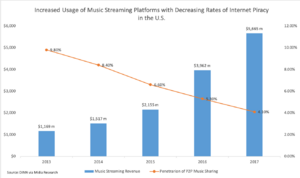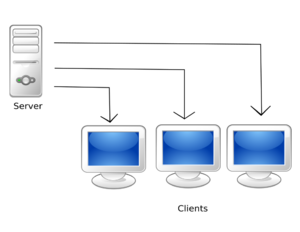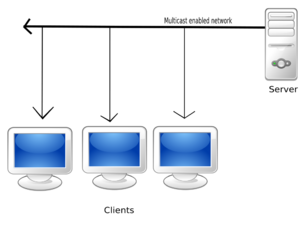Streaming media facts for kids
Streaming media is a way to watch or listen to videos and music over the internet without fully downloading them first. Imagine watching a movie online: you don't have to wait for the whole movie file to download before it starts playing. Instead, the data comes to your device in a steady "stream" of small pieces. Your device plays these pieces as they arrive.
This is different from downloading, where you get the entire file before you can open it. Streaming is super popular for things like video on demand (like Netflix), streaming television, and music apps (like Spotify). While most people think of streaming over the internet, it can also happen between devices in your home, like using Bluetooth to play music on a wireless speaker. Streaming became popular in the 1990s and is now the main way people enjoy music and videos around the world.
Streaming isn't just for video and audio. It can also be used for things like closed captioning (subtitles that appear live) or real-time text (text that shows up as it's being typed).
Contents
What is Streaming?
The word "streaming" first came from how tape drives worked in the 1990s. These drives would slowly start up and play a whole track. Later, the term was used to describe video on demand and live video over computer networks. It was a better way to explain how video and audio were sent without being fully downloaded first.
Early Ways to Stream
Even before the internet, people found ways to "stream" entertainment:
- In 1881, the Théâtrophone let people listen to opera and theater shows over telephone lines. This lasted until 1932.
- In the 1920s, George Owen Squier created a system called Muzak. This sent continuous music to businesses, like stores and restaurants, without using radio.
- The Telephone Music Service started in 1929. Customers in bars could use a phone on a jukebox to ask an operator to play a song. The operator would play the record in a studio, and the music would travel over telephone lines to the bar. This service lasted until 1997.
History of Streaming
How it Started
People tried to show media on computers a long time ago. But it was hard because computers weren't powerful enough. By the late 1980s and 1990s, home computers became strong enough to handle different types of media. The main challenges were making sure computers could handle the data fast enough and play it smoothly. In the mid-1990s, internet connections were still slow. So, people usually played audio and video from a local hard disk drive or CD-ROM on their computer.
In 1990, the first commercial Ethernet switch was made. This helped create stronger computer networks. These networks then allowed the first streaming video to be used in schools and businesses.
Streaming media became truly possible because of better ways to compress data. Without compression, media files are huge! For example, one minute of uncompressed CD quality audio needs 1.4 Mbit/s of internet speed. A minute of standard video needs 168 Mbit/s, and high-definition video needs over 1000 Mbit/s. Compression makes these files much smaller, so they can travel over the internet more easily.
Late 1990s to Early 2000s
In the late 1990s and early 2000s, more people got access to the internet. Internet speeds also got much faster. These improvements made it easier to stream audio and video to homes and workplaces. Standard ways of sending data, like TCP/IP and HTTP, also became more common. This led to more money being invested in internet businesses.
The band Severe Tire Damage was the first group to perform live on the internet. This happened on June 24, 1993. Their performance was broadcast live to places like Australia. A band member later said they used about "half of the total bandwidth of the internet" to stream a very small video (152x76 pixels) with poor audio quality.
RealNetworks was a pioneer in streaming. They broadcast a baseball game over the internet in 1995. The first symphonic concert on the internet also happened in Seattle in November 1995.
In 1996, Marc Scarpa produced the first big live online broadcast, the Tibetan Freedom Concert. This event helped show how live streaming could be used for social causes.
Business Growth
Many companies started creating streaming technology. Xing Technology made "StreamWorks" in 1989. Starlight Networks created "StarWorks" in 1992, which allowed on-demand videos over corporate networks. Other early companies included Progressive Networks (later renamed RealNetworks) and Protocomm.
After the internet became very popular in the late 1990s, many new streaming video companies appeared. These included Vivo Software, VDOnet, and Precept.
Microsoft developed ActiveMovie in 1995, which supported streaming. This later became part of Windows Media Player. In 1999, Apple also launched its own streaming format with QuickTime 4. For a while, people needed to download different apps (RealPlayer, Windows Media Player, QuickTime) to watch different streaming videos online.
Around 2002, people wanted one standard streaming format. Adobe Flash became very popular, leading to a video streaming format through Flash. The first very popular video streaming site, YouTube, started in 2005. It first used a Flash-based player. Now, YouTube uses HTML video and also offers live streaming.
By 2015, streaming services became the biggest source of income for the music industry in the US. They brought in about $2.4 billion, growing 29% from the year before.
Streaming Wars
The term streaming wars describes the big competition between video streaming services. This started in the late 2010s. Companies like Netflix, Amazon Prime Video, Hulu, Max, Disney+, Paramount+, Apple TV+, and Peacock are all competing for viewers.
To stand out, these companies create their own exclusive shows and movies. This means you often have to subscribe to several services to watch everything you want. This can make it more expensive for viewers. However, when content is available on a streaming service, people are less likely to search for illegal copies.
The competition grew even more during the COVID-19 pandemic. More people stayed home and watched TV. But by 2022, audience growth slowed down. This led services to focus more on making money. They started cutting production budgets, stopping password sharing, and adding cheaper plans with ads.
In September 2023, many streaming services formed a group called the Streaming Innovation Alliance (SIA). This group includes Disney+, Hulu, Max, Netflix, Paramount+, and Peacock.
How People Use Streaming
Thanks to better computer networks and powerful home computers, streaming media is now easy and affordable for everyone. Special Internet radio devices let people listen to audio streams without needing a computer. Streaming music became very popular, with 118.1 billion streams in 2013.

Videos and music files are very large. So, they are usually compressed (made smaller) to save space and make them easier to send. People want to stream high-definition (HD) content. This has led to new technologies like WirelessHD and G.hn that are great for streaming HD. Many apps now let you stream HD content on smaller devices like tablets and smartphones.
A media stream can be live or on demand.
- Live streams happen in real-time, like a live concert or a sports game. The information goes straight to your device without saving a full file.
- On-demand streaming lets you watch or listen whenever you want, like a movie on Netflix. The information is often saved to a temporary file on your device as it plays.
Streaming media is also often used with social media. Sites like YouTube have live chat and comments during webcasts. Streaming is also used for online learning and business meetings.
A 2017 report found that 70% of people watched content through a streaming service. For Millennials (young adults), 60% of their content was streamed.
From DVDs to Streaming
The rise of movie streaming greatly affected the DVD industry. DVD sales and rentals dropped a lot. Many DVD rental companies, like Blockbuster, closed down. In 2015, Netflix still had 5.3 million DVD subscribers, but their streaming service had 65 million members! This shows how quickly streaming took over.
Napster and Music Streaming
Music streaming is one of the most popular ways people use streaming media. The way we listen to music changed a lot with the internet.
Napster was a peer-to-peer (P2P) file-sharing network that launched in 1999. It let users upload and download MP3 music files for free. This was a huge change for the music industry. Before Napster, you had to pay for music. Now, songs were free for anyone with internet access.
Napster grew incredibly fast, reaching about 80 million users worldwide. It became so popular that many college campuses had to block it. Too many students sharing music files slowed down their networks!
Napster's success led to other P2P sites like LimeWire (2000) and BitTorrent (2001). But the time of free P2P music sharing didn't last long.
The Lawsuit Against Napster
Many record labels and the Recording Industry Association of America (RIAA) sued Napster. They said Napster was allowing people to illegally share copyrighted music. In 2001, a court ruled that Napster was responsible for copyright infringement. This forced Napster to shut down.
This court case, A&M Records, Inc. v. Napster, Inc., was very important for Intellectual property law. The court said that Napster was not using the music for "fair use" (like for criticism or teaching). Instead, it was letting users copy music over and over, which hurt the music's market value. The court found that most files on Napster were copyrighted.
The ruling meant that copyrighted digital content cannot be freely copied and shared without the owner's permission. This made the rights of artists and record labels much stronger.
Modern Music Streaming
Even though music streaming isn't free like it was with Napster, platforms like Spotify, Deezer, Apple Music, SoundCloud, YouTube Music, and Amazon Music are very popular. Most of these services require a monthly fee to access their music library. Some, like Spotify, offer a free version with ads and limited features.
There's competition between these music streaming services, similar to the "streaming wars" for video. As of 2019, Spotify had over 207 million users. Apple Music had about 60 million, and SoundCloud had 175 million.
The music industry first reacted negatively to streaming and piracy. Music sales dropped a lot between 1999 and 2009. But by 2018, music streaming income was higher than traditional sales like CDs. Streaming is now a major reason for growth in the music industry.
Streaming During COVID-19
By August 2020, during the COVID-19 pandemic, streaming services became busier than ever. In the UK, 12 million people joined a new streaming service they hadn't used before.
While digital music streaming income increased during the pandemic, it didn't fully make up for the money artists lost from concerts and live performances. However, the global music market grew by 7.4% in 2022, mainly because of paid music subscriptions.
The pandemic also led to more false information being spread, especially on streaming platforms like YouTube and podcasts.
Streaming at Home
Streaming also happens within your home network. Technologies like DLNA let devices on your home network connect and share media. For example, you can stream a movie from your computer to your smart TV. This is even easier with network-attached storage (NAS) devices or special software like Plex Media Server.
How Streaming Works
Internet Speed Needed
To stream standard-definition video, you usually need an internet speed of 2 Mbit/s or more. For high-definition (HD) content, 5 Mbit/s is recommended. For ultra-high-definition (UHD) content, you need about 9 Mbit/s.
The size of a streamed file depends on its length and the bit rate (how much data per second). For example, one hour of video streamed at 300 kbit/s (a common speed in 2005) uses about 128 MB of storage.
If 1,000 people watch the same video at the same time using a Unicast protocol (where each person gets their own copy), the server needs a lot of internet speed: 300 Mbit/s. This is like 135 GB per hour! But if a multicast protocol is used, the server only sends one stream for everyone, so it uses much less bandwidth.
In 2018, video made up over 60% of all internet data traffic worldwide.
Technical Rules (Protocols)
Video and audio streams are compressed to make them smaller. Common audio formats include MP3 and AAC. Video formats include H.264 and HEVC. These compressed streams are put into a container file like MP4 or WebM. This file is then sent from a streaming server to your device using special rules called transport protocols, like RTMP or RTP.
More recently, technologies like Apple's HLS and MPEG-DASH let streaming happen over regular HTTP (the same rules your web browser uses). This is often used to send video from a live event to a cloud service, which then sends it to many individual users.
Designing these network rules for streaming is tricky. Some rules, like User Datagram Protocol (UDP), send data in small packets. This is fast, but if a packet gets lost, the stream might briefly stop or skip. Other rules, like Transmission Control Protocol (TCP), make sure every piece of data arrives correctly. But if data is lost, the stream might pause while the missing data is resent. To avoid pauses, devices often store a small amount of data ahead of time in a "buffer."
Unicast protocols send a separate copy of the stream to each person watching. This is common for most internet connections. But it's not efficient if many people want to watch the same live TV show. Multicast protocols were made to fix this. They send a single stream from the source to a group of people, saving server and network power.
Peer-to-peer (P2P) protocols let streams be sent between different computers. This helps prevent the main server from getting overloaded. However, it can create other issues with performance and security.
Content delivery networks (CDNs) use many servers spread out in different locations. This helps distribute the streaming load and deliver content faster to users.
Recording Streams
Live streams can often be recorded using media players like VLC player or screen recording software. Many live-streaming platforms, like Twitch and YouTube, also automatically record live broadcasts. This lets you watch them later, even if you missed the live event.
Recommendations for Viewers
Most streaming services have a recommender system. This system suggests what you might like to watch next based on what you've watched before. It also looks at what other people with similar viewing habits have watched. This helps you discover new shows and movies you might enjoy.
Uses and Marketing
Streaming is great for things like long video lectures online. You can pause them or rewatch parts whenever you want. Streaming also helps businesses with marketing. For example, the Berlin Philharmonic Orchestra sells live internet streams of their concerts. The Metropolitan Opera in New York does something similar. There's even a livestream from the International Space Station!
In entertainment, streaming platforms like Netflix, Hulu, and Disney+ are now a huge part of the media world. Marketers use streaming to reach people with ads. Digital marketing has grown a lot, especially since the COVID-19 lockdowns. Streaming platforms offer new ways to advertise because they can use data to show personalized ads to viewers.
Challenges
Copyright Issues
One big challenge for streaming services is copyright. When you stream copyrighted content, it involves making copies of that work. This can be a problem if it's done without permission. Recording and sharing streamed content without permission is also a concern for companies that make money from views or attendance.
- Comparison of music streaming services
- Comparison of streaming media software
- Comparison of video hosting services
- Content delivery platform
- Digital television
- Internet Protocol television
- List of streaming media services
- List of streaming media systems
- M3U playlists
- National Streaming Day
- Over-the-top media service
- P2PTV
- Smart TV
- Stream ripping
- Video over cellular
See also
 In Spanish: Streaming para niños
In Spanish: Streaming para niños






